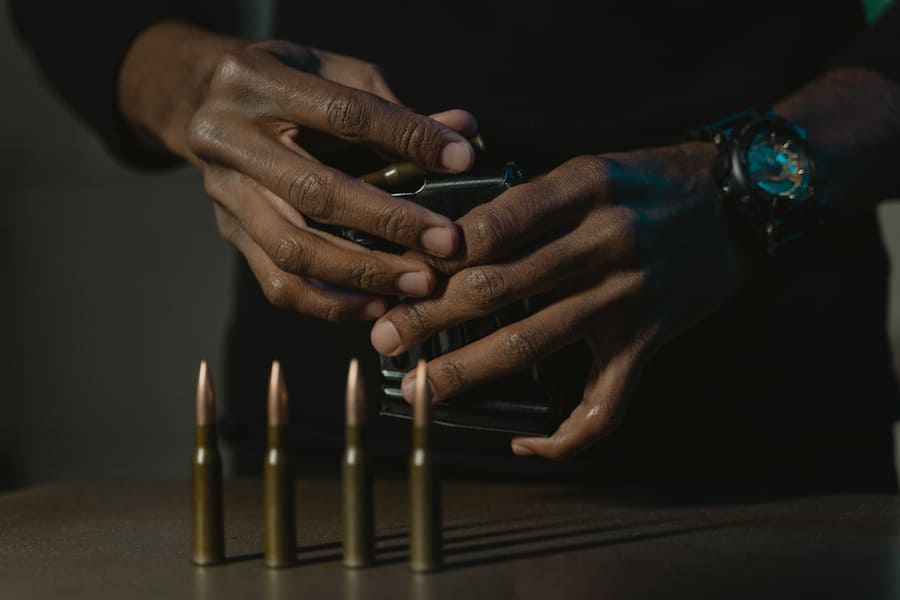As an Amazon Associate we earn from qualifying purchases.
If you’re a new gun owner purchasing ammunition, you might have noticed the word grain along with some numbers on an ammunition box. This refers to the grain weight of the ammo. Are you curious to know what is grain weight is in bullets?
Contents
What Is Grain Weight in Bullets?
The weight of a bullet is commonly measured in grains using a balance. A pound is equal to 7000 grains. An ounce is equal to 437.5 grains. The weight of the bullet can indicate the type of cartridge that may have contained the bullet.

However, the bullet should be relatively intact. Grain weight is one of the factors that determine cartridge type used commonly by law enforcement and forensics.
Grain Weight and Cartridge Type
Below is a table consisting of popular small calibers and their corresponding grain weight.
| CARTRIDGE | WEIGHT RANGE (Grains) |
| 17 Remington | 25 |
| 22 Short | 27 – 30 |
| 22 Long Rifle | 36 – 40 |
| 22 Win Mag | 30 – 50 |
| 25 ACP | 45 – 50 |
| 7.62 Tokarev | 84 – 92 |
| 7.65 (30 Luger) | 90 – 96 |
| 32 S&W | 85 – 88 |
| 32 – 20 WCF | 90 – 115 |
| 32 Short Colt | 80 |
| 32 Long Colt | 82 |
| 32 S&W & 32 S&W Long | 95 – 100 |
| 32 Auto | 60 – 71 |
| 8mm Nambu | 99 – 103 |
| 380 Auto | 85 – 102 |
| 9mm Parabellum | 88 – 147 |
| 9mm Makarov | 90 |
| 9mm Steyr | 114 – 118 |
| 9mm Mauser | 123 – 128 |
| 38 S&W | 145 – 150 |
| 38 Long Colt/Colt New Police | 148 – 150 |
| 38 Special | 95 – 158 |
| 357 Magnum | 110 – 180 |
| 38 Auto | 115 – 147 |
| 40 S&W | 141 – 180 |
| 10mm Auto | 155 – 200 |
| 41 Rem Magnum | 170 – 240 |
| 41 Short Colt | 160 – 167 |
| 44 Rem Magnum | 180 – 275 |
| 44 S&W Special | 200 – 246 |
| 45 ACP | 175 – 230 |
| 45 Colt | 225 – 255 |
Is Heavier Better?
Heavier grain weight has its own advantages. Most people choose to use heavier bullets because they want better expansion and penetration. Expansion and penetration are also affected by other factors like:
- Bullet shape
- Material
- Distance
- Muzzle velocity

Pros of Lighter Grains
- More speed. The better the speed, the straighter your trajectory will be for high-accuracy shots. This is why lighter bullets are great for long-range shooting.
- Because of its high accuracy, lighter bullets are favored in competition shooting where accuracy is measured.
Cons of Lighter Grains
- Lighter bullets mean that they can be influenced by wind. Strong winds could easily affect the trajectory and accuracy of your shots using lighter bullets.
- Lighter bullets deal less damage to the target. If you want to kill a pest or game humanely, you may want to use heavier bullets so they don’t suffer.
Pros of Heavier Grains
- Heavier bullets are likely resistant to the wind so they are more accurate in windy weather.
- Heavier bullets have better power and penetration on impact.
Cons of Heavier Grains
- Heavier bullets aren’t great for long-distance shooting.
- Heavier bullets can generate strong recoil. This may be unique for each shooter since recoil management varies with people.

Related Questions
What Is a Good Grain for a Bullet?
It depends on your personal preference. The most commonly used grains for bullets are 55-grain for 223 Remington and 115-grain for 9mm Luger. This could be a standard start point for a beginner.
Why Are Bullets Weighed in Grains?
Grains are also a part of the unit measurement of mass. The weight of the grain is extremely small. So if you use grams or kilograms, you would have to write a lot of numbers.
Conclusion
Knowing grain weight in ammunition is helpful. There are certain grain weights that you might want to choose for certain calibers if you want to get the best ammunition. You also don’t want to make the wrong purchase because you don’t know what grain weight means.
